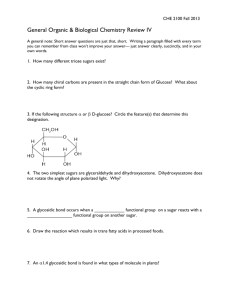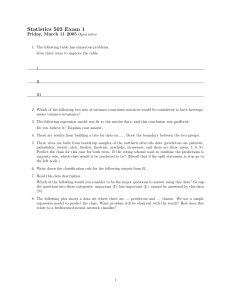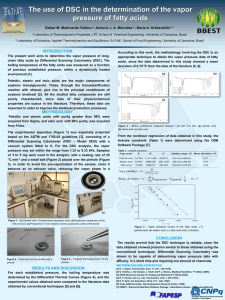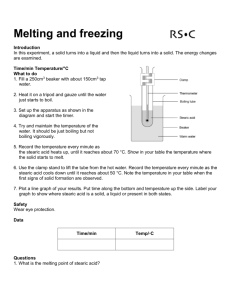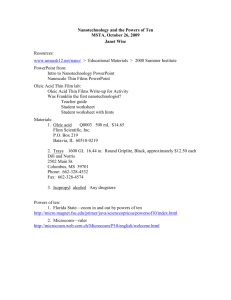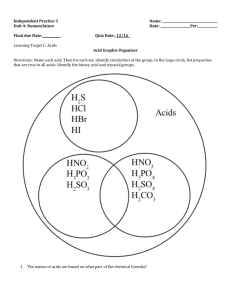M1I S WITH N
advertisement
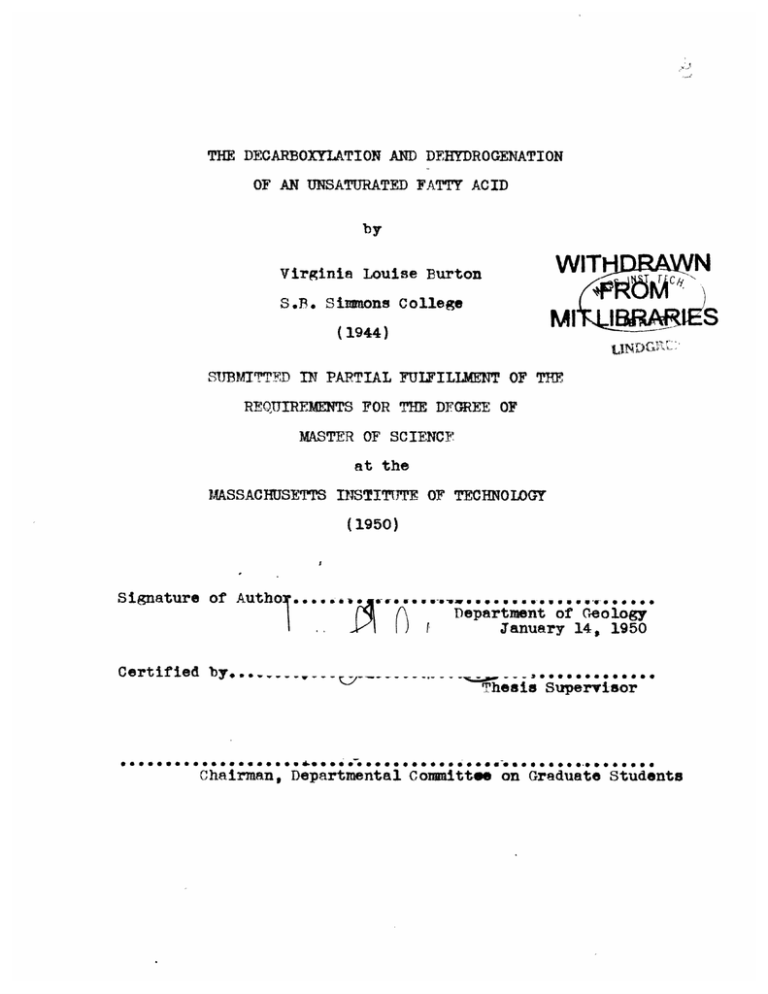
THE DECARBOXYIATION AND DERYDROGENATION OF AN UNSATURATED FATTY ACID by WITH Virginia Louise Burton S.B. Simmons College M1I (1944) llIR UINDr" SITBMITTED IN PARTIAL FULFILLMENT OF THE REQUIREMENTS FOR THE DFGREE OF MASTER OF SCIENCE at the MASSACHUSETTS INSTITUTE OF TECHNOLOGY (1950) Signature of Autho ... W... ....... 0. 6 . .00 0*. Department of Geology January 14, 1950 Certified by.. ............. Thesis Supervisor Chairman, Departmental Committe on Graduate Students N S I Acknowledgments The author wishes to thank Prof. Prof. $lark Goodman and .L. Whitehead for their encouragement and counsel. Considerable advice and assistance was given by I.A. Breger. Mass spectrometric analyses were obtained by Earle C. Farmer and through the courtesy of Dr. R.E. Honig of the Socony Vacuum Company. The deuteron bombardment was carried out through the cooperation of Mr. Farmer, Dr. Eric Clarke, and the MIT cyclotron crew. The alpha bombardment was made by Dr. CV. Sheppard. The author also wishes to express her appreciation to Robert McDonald.and Elaine Hungerman for the infrared spectrum, and to Dr. W.C. MoCrone of the Armour Research Foundation for his assistance in the interpretation of the spectrum. I TABL OF CONTENTS Page Introduction 1 Summary of Results 9 Experimental 12 Alpha Bombardments 1z Gas Analysis (Low temp.-Combustion) 14 Deuteron Bombardment 14 Purification of Oleic Acid 19 Separation of Stearic Acid 20 Polymerized Acids 24 Isolati on of Heptadeaene-8 35 Conclusions 30 Bibliography 33 I INTRODUCTION T"he origin of petroleum has long been a subject for controversy. Many theories have been proposed for its origin, but it is now generally conceded that oil originates from the deposition and decomposition of marine organisms, plankton in particular. The actual agent or agents of decomposition are still in doubt. Only a very small proportion of the organic matter present in the sea accumulates to become petroleum source material. The elementary compounds- sugars, fats, and simple proteins- are decomposed during deposition and occur in sediments in very small amounts. The more resistant compounds are deposited to a greater extent, and these in turn decompose after burial tending to become more complex. Table I shows the changes which take place efter burial, in the protein, carbohydrate, and fat content of plankton, as well as the carbon, hydrogen, oxygen, and nitrogen content.aI The decomposition is essentially one of reduction, that is the removal of oxygen. The ocean water and sur- face layers of the sediments probably contain sufficient oxygen to support aerobic bacteria. These organisms split off amino acids and lower fatty acids which are decomposed into carbon dioxide, water, and ammonia. Most of the decomposition, however, is due to anaerobic bacteria which obtain their life-giving oxygen from the compounds in the sediments. The bacteria may therefore, TABLE I Petroleum Plankton Recent Sed. 24 40 3 1 Carbohydrates &other non-nitrogenous cpds. 73 60 Carbon 46 56 83-87 8 8 11-14 39 30 5 6 traces to 2 - 3 Protein Fat Hydrogen Oxygen Nitrogen - - be important factors in petroleum genesis because they lower the oxygen, nitrogen, and sulphur content of the organic constituents, thus making the residue more' petroleum-like than the original material. As these processes continue, the amount of available energy will become so small that the anaerobic bacteria which are presumably the final living things to alter the organic matter will no longer be able to exist. Below this depth the material will be altered by inorganic and physical sources of energy, such as pressure, catalysis, temperature, and radioactivity. It has been postulated that the thickness of sediment in which petroleum has been formed is about 5000 feet. The hydrostatic head would not be much greater than 2000 p.s.i. whereas overburden pressure would be about 5000 p.sA.i. Little investigation has been carried on as to the effect of such pressures on organic material. Catalysis as a mechanism in petroleum genesis is another possibility which has not been investigated very thoroughly. Both organic and inorganic substances occurring in sea water could act as catalysts. Metallic elements such as nickel, vanadium, lead, and iron are found in petroleum as organo compounds. enzymes may act as organic catalysts. Bacterial Inorganic compounds such as silica, hydrous aluminum silicates, iron oxides, sodium chloride, sulphates, sulphides, and carbonates may have some bearing on petroleum genesis. Geologic history indicates that maximum temperatures in most oil basins have probably been about 100o0 C. Most organic compounds are very stable at this temperature, but coupled with the element of geologic time and a catalyst which would lower the activation energy, temperature may play an important role in transforming the organic matter of sediments into petroleum. Another factor which may supply the energy necessary to transform the organic material of sediments into petroleum is the radiations from the radioactive substances known to be present universally in the earth's crust. Sediments lying in deep water and far enough from shore so as not to receive the immediate detritus, contain more radium than igneous and sedimentary rocks other than marine shales, and far more than the ocean water. From Table II one can observe how efficient the mechanism for concentrating the radium in ocean sediments has been. A' Trask reports that the more organic material there is in a sediment the finer is its texture. Beers' found that the finer textured shales were more highly radioactive than coarser sedimentary rocks. If these two features- organic matter and radioactivity are thus concentrated in fine textured shales, there is good reason to believe TABLE II Ratio of the Radium Content of Ocean Water to that of Rocks Ocean Water 0.8 x 10-*16 g. Ra./**G. Sedimentary Rooks 1,000 Igneous Rooks 10,000 Olobegerina Ooze 60,000 that their interaction may be favorable for the genesis of petroleum. Beers attributes the high radioactivity of fine textured shales to a co4loidal environment with resultant sefotive adsorption. In measuring the radioactivity content of marine sediments, Piggot and Urry found that the concentration of uranium on the ocean bottom was insufficient to support the content of ionium, a daughter element of uranium. In other words some mechanism for concentrating the ionium in the sediments was in effect. Living organisms are knowm to be capable of extracting inorganic elements from the sea. For example, certain seaweeds extract iodine from ocean water. Both these mechanisms- colloidal adsorption and concentration by organisms- suggest an intimate relationship between radioactivity and organic material which would be favorable to petroleum genesis. Lind and BardwellI in 1926 were the first to sug-est that the radioactive constituents of sedimentary rocks might be the source of energy needed to convert gaseous paraffins to petroleum. Bell, Goodman, and Cal Whitehead pointed out that a more feasible process for petroleum genesis, from a geological consideration, was the decomposition and conversion of the solid and semisolid compounds in marine sediments. It was for the purpose of studying the effects of radioactivity on pure organic compounds and complex organic extracts from marine sediments that the American Petroleum Institute Project 43c was established at MIT. Because Wells and Erickson, and Trask and Wu found from 2 to 34 parts of fatty acids per 100,000 parts of sediment, and Clarke and Mazur found 60 to 80% of acids in the ether extractable lipids from diatoms, several of the fatty acids were bombarded. It was found that paraffin hydrocarbons could be produced by the decarboxylation of the acid: RCOOH > RH 002 The theory that radioactivity plays a part in petroleum genesis was subject to considerable criticism because hydrogen was the major component of the gaseous products. Hydrogen occurs only in minute quantities in the natural gases associated with petroleum. Although it had been proposed that this gas could diffuse through the cap rock, it seemed likely that the unsaturated compounds in source sediments might be hydrogenated under the influence of radioactivity and thus absorb at least part of the hydrogen produced. Benzoic acid was the first unsaturated ait compound to be bombarded in an effort to determine if hydrogen produced by the decomposition of one mole- cule would, under the influence of radiation, enter the ring of another molecule. The volume of gas wa produced was very small; it consisted of 85% of carbon dioxide and only 1.e, of hydrogen. No evidence has been found for the formation of the saturated compounds, hexahydrobenzoic acid or cyclohexane, and attempts to identify the infusible reaction product have been unsuccessful. Because considerable data were available concerning the effects of radioactivity on the fatty acids, a carefully purified sample of oleic acid was bombarded with alpha particles from radon and with deuterons in the MIT cyclotron. Surmary of Results Gaseous products from the cyclotron bombardment were analyzed on a mass spectrometer and found to consist mainly of carbon dioxide end hydrogen. Table III shows the complete analysis of the alpha and deuteron bombardments. The columns under "deuteron" represent analyses of the gas samples collected during each thirty minute period of the two hour run. There appears to be a consistent increase in hydrogen and decrease in carbon dioxide during the irradiation. The acid .changed from a light colorless liquid to an amber, fluorescent, highly viscous material resembling heavy imotor oil. Thirty onepercent of the original oleic acid remained after bombardment. Of the material converted, 10f% was recovered as non-saponifiable, 52.$9 as polymerized acid, and an estimated 1.7% as stearic acid. Thirty percent of the non-saponifiable material was separated as heptadecene (3% of the original oleic acid). The number of molecules of oleic acid converted per one hundred electron volts of energy input was 2.16. Likewise the number of molecules of stearic acid formed was 0.047. This indicates thategpproximately 2.5 molecules of stearic acid were formed for every one hundred molecules of olet acid that were converted. TABLE III Gaseous Bombardment Products from Oleie Acid Volume 'f Components Deuterona Out 1 H2 00 2 Cut _ Alphab Cut 3 Cut 4 41.62 44.0 55.1 56*4 50*0 4104 42.6 32. 28.8 41.0 CO 5.8 4.5 2.9 6.8 H20 3.5 2.9 4.8 0.7 CH 4 3.9 0.4 0.5 4.2 C 0.4 1.2 1.0 1.1 C 2H4 3.9 0.4 1.1 1.9 C3H8 1.5 0.5 04H10 1*6 0.9 041B 0.6 05H12 0.4 0.2 C5 H 0.4 0.1 10 Alp C6H12 0.3 C7H16 0.1 0 0.1 14 a !as spectrometric Analyses b Low temperature - combustion analysis 6.0 1.8 - The following material balance was drawn up for the bombardment: Reactant 00201 moles Oleic acid Products (Total moles liberated) Oleio acid (recoveied after bomb.) 0.063 Carbon dioxide 0.043 Hydrogen 0.066 Other gaseous products 0.019 Heptadecene 0.007 Stearic acid 0.003 Polymeric acids (52.5%) and uninunknown non-saponifiables (77) Total 0.201 The moles of polymeric acids formed could not be calculated because of the difficulty in determining the molecular weight of the nterial. The acids were in- soluble in the solvents commonly used for this purpose and a high molecular weight is therefore inferred. PIperimental Alpha Bombardment: - The oleic acid was coated on the inside of a 200 ml. bulb, solidificd aT Oo C. and maintained at that temperature for the duration of the bom*bardment. As shown in Fig. 1, the stem of the bulb contained n "hook seal" A of thin glass tubing which could be broken with a magnetic plunger at the time of analysis of the gaseous products of the bombardment. Radon in glass needles was introduced into the side chamber C through tube B. The entire system was next evacuated and then sealed off at B. By careful shaking, a glass bead in the side chamber broke the radon-containing needles, and the gas diffused into 9(B A C R 0 Figure 1 Alpha bombardment bulb 5 p the bulb in which the oleic acid was coated, was measured on the manometer M. The pressure After a period of six weeks when the activity had declined to a negligible level the gas was analyzed. (Table III) Gas Analysis (Low temperature - combustion):The apparatus in which gas analyses were made is shown in Fig,. 2. The following procedure was used: carbon dioxide was absorbed by potassium hydroxide. The remaining fraction was then condensed with liquid air and the non-condensibles absorbed by "Cosorbent" to determine the carbon monoxide. The residue was next burned with excess oxygen and the percentages of hydrogen and methane were computed from the volume contraction after combustion and the amount of carbon dioxide produced. Deuteron Bombardment:Because insufficient solid and liquid materials were produced during the alpha particle bombardment, a large scale deuteron bombardment was undertaken in the apparatus designed by R. E. Honig Fifty seven grams of oleic acid were bombarded for two hours in the cyclotron with an average beam intensity of nine microamperes. Figures 3 and 4 show the details of the chamber. The beam is admitted through a rectangular 2 mil copper LA L 3volts T n0 5 SCALE-cm "ig. 2 Ges analysis apparatus (low temperature-combustion) 1 r ----- SCALE 0 i OI E 3 IC . 3INCHES FIG. 1. Scale drawing of gas chamber. a. Side view; b. top view; c. section AA; d. assembly, partially cut away; e. top plate (section BB). F~.a~th.tmocstIp4o Figue 5 - 1) 2) 3). 4) Insulated lead-ins Hoke valves Presae gauge I' 1 H I I IE~ 0 I 2 3 INCHES F1G. 3. Scale drawing of liquid target-holder. a. Si de view; b. section AA. aV Figure 4 (7) Location of top plate ()Internal spacer ()Rubber gasket I foil window (1 & 2, Fig. 3) in the side of the brass (31 chamber. Water coolingAis necessary because of the amount of heat dissipated. 17* temperature of the oleio acid during tht bombardment was measured ty a copper constantan thermocouple (9) connected to the outside through two insulated lead-ins (11). Gas pressure was measured by a Bourdon gauge (13) connected to a microtorque potentiometer (14) which transmits the movements of the gaage needle to the control bench. Figure 4 shows details of the target which holds 117 ml. of liquid in a rectangular box (1) the front of which consists of 2 nil copper foil (2). Above the open top is a plate (3) which will condense and return to the target any distillate formed during the bombardment. The thermocouple (4) which measures the temperature of the liquid is suspended from the roof and extends into the liquid without actually being in the bean. The con- tainer is supported by a water-oooling coil (7), In order to prevent interaction of the metal in the chamber and compounds being bombarded, the entire inside Of the gas chamber, target holder, and thermocouple are goldi. plated. Gas produced during the bombardment was col§Lected in three evacuated $*I. 1. bulb. bulbs and the residue in t /A Purification of OleiO Acid:Several methods for the purification of the oleic acid were attempted, but the procedure of Wheeler and Riemenschneider was used. This method consisted of the fractional distillation and crystallization of the methyl esters followed by hydrolysis and distillation of the acid. Technical oleic acid (2 1.) obtained from the Eastman Kodak Company, Rochester, New York,was converted to the methyl ester by refluxing with 2 1. of methanol and 75 ml. of sulfuric a&id for three hours. The methyl ester was then fractionated under 1-2 mm. of mercury in a two foot jacketed Vigreux column to give 1765 ml. of product. To simplify handling, all crystallizations were carried out batchwise. The ester (1320 ml.) was dissolved in 16.8 1. of acetone and cooled to -600 with stirring to remove the linoleic and linolenic acids. The heavy white precipitate of methyl oleate was rapidly filtered on a Buohner funnel maintained at the crystallization temperature byADry Ice-acetone jacket. The crystals were allowed to melt, the material was dissolved in acetone (10 ml. per g.), and then crystallized at -370 C to remove palmitic and stearic acids. The precipitate was filtered on a Bulchner funnel as before. This pro- As. i, cedure was repeated twice and vs then followed by another -600 crystallization. Yield, 480 ml. Unlike the method of Wheeler and Rieuenschneider, which included a second distillation of the methyl esters followed by twq erystallizations at -650, the methyl oleate was next hydrolized with alcoholic potassium hydroxide. The soap formed was carefully neutralized with hydrochloric acid to recover the pure acid which was then fractionated under 1 mm. of mercury to yield 75 ml. of oleic acid; b.p. 220-221/1.5 mm., n0 1.4592, freezing point (from curve) 5.74O-8.920 0. Small per- coentages of linoleic and linolenic acids were probably present in the final product, but the presence of these compounds was of little importance to the object of this work. Separation of Stearic Acid:After the bombardment, 20 g. of the thick viscous product was saponified by refluxing for three hours with 50 ml. of 10% sodium hydroxide and 100 ml. of alcohol. The amber-colored solution was decanted from the insoluble polymerised acids and was then extracted with ether, enough water being added to give two phases. A small amount of hexane was added to cut down the solubility of the water in the ether. The sodium hydroxide solution was acidified with excess hydrochloric acid and was ettracted with ether, dried over sodium sulphate and evaporated on a steam bath. I The iesidue was made up to 100 ml. with pentane in a volumetric flask (6.7 g., 33.5% of the oleic acid bombbarded). To a 30 ml. aliquot was added 70 ml. of pentane, 15 ml. of ether, and 2 ml. of benzene to obtain a clear solution which was then passed through a 12 x 800 mm. column packed with a mixture of five parts of J. T. Baker's alumina to one part of Celite 545. The filtrate was washed with 175 ml. of the pentane-ether-benzene solution, 50 ml. of pentane containing 10'& methanol, and,120 ml. of pentane containing 20% methanol. A total of forty four 10 ml. cuts was collected. Fractions 29-44 contained an infusible solid in each flask after evaporation of the solvent. When ether was added the precipitate swelled and became very gelatinous. Following hydrolysis of several of the above cuts with hydrochloric acid, extraction with ether, and evaporation of the solvent, an oily residue remained) indicating that the acids had come through the column as aluminum salts. Since a solid residue was recovered from cut 44 after hydrolysis, cuts 29-44 inclusive were combined, hydrolyzed, extracted with ether, and dried over sodium sulphate. After the ether was evaporated on a steam bath, 90 mg. of solid material was evaporated from the above cuts by crystallization from acetone at -200 C. I The chromatographic column was next out into four sections each of which was eluted with metnanol. The three lower sections contained gelatinous precipitates which, after hydrolysis1 yielded solid residues. A (m.p. 500) total of 175 mg. of solid materialAwas separated from the column and the filtrates. By means of six crys- tallizations from acetone at -200 in r centrifuge tube, the melting point of this solid was raised to 69.50. A mixed melting point with authenic stearic acid was 700 (stearic acid, m.p. 700). All melting points were taken on a microscope hot stage. The analytical scheme to this point is shown in rig. 5. Because the loss of stearic acid during recrystallization was so great, it was necessary to use an indirect method to estimate the amount present. A blank chromat- ogram containing 3% of stearic acid (42 mg.) in the purified oleic aied was next run. Seventy four milligrams of solid acid (m.p. 500) was separated as above. From melting point curves for mixtures of oleio and stearic acids * it was established that the isolated material contained 25% of stearic acid, a recovery of 18.5 ng. or 44%. The solid separated from the bombarded oleic acid (175 mg.) also contained 25% of stearic acid (43.8 mg.) as indicated by its melting point of $ 500. After cor- recting for the 44% recovery by chromatography, as shown AS. Oleic Acid (56.8 g.) Deuteron bombardment Yellow Viscous Product Reserve ( 30 g.) Analysis (2.0.134 g.) Saponificetion, extraction, hydrolysis Polymerized Acids (10.5 g., 62.$5) Acids (6.7 go,33.5 t t) Non-saponifiables (2 gin 10en) Solution (to 100 ml. in pentane Reserve (70 ni1.) Aliquot (30 ml., 1.91 g.) Chromatography on alumina Fractions 29-44 (90 mg. solid acid) colid (85 mg. solid acid) Solid Acids Solid Acids (mvp. 500, 175 mg.) 6 recrystallizations Stearic Acid (m.p. 69*50, 20-25 mg.) Fig. 5. - Analytical scheme used in separating Stearic acid. ., above, it was found that the stearic acid isolated (100 mg.) amounte 5.3/ of the non-polymerized saponifiable material. On the basis of the original acid bombarded this figure becomes 1.?f, Since the stearic acid had been concentrated by a factor of nearly three upon the removal of the polymeric acids and the 4P nonsaponifiable material (62.5%), it was necessary to determine if the acid (147%) represented original impurity which was below the limit of detection using the unbombarded oleic acidi A sample of the purified oleic acid to which was added i$ of stearic acid was, procedure therefore, chromatographed by the same Aand the stearic was easily detectable. No stearic acid could be isolated when the oleic acid itself was chromatographed. This work indicated that the original oleic acid contained less than lf of stearic acid and that the bombarded acid contained approximately 1.7%, both values being determined by the same analytical technique. It was thus shown that oleic acid was hydrogenated to stearic acid. A second product of the bombardment was a viscous material- remaining in the flask after saponification. This material, which was insoluble in the alcoholic solution and in the ether, went into a soapy solution in water. After hydrolysis, these polymerized acids, which were now ether soluble, weighed 10.5 g. (52.504 of the total oleic acid bombarded). Although an infrared I analysis has been run, no further data have been obtained. It appears that polymerizatien-bdcurs tan'alresult of unsaturation since no polymerized acidic material bad been recovered in earlier bombardments of saturated fatty acids. Isolation of Heptadecene-e:Early investigations *rbave shown that decar- boxylation is a predominant rection during the exposure of fatty or naphthenic acids to alpha particles or to deuterons. RC00H - RH + 002. Heptadecene-8 was therefore anticipated as the major decarboxylation product from the irradiation of oleic acid. Nine hundred and fifty milligrams of the yellow, viscous, non-saponifiable fraction was dissolved it 100 ml. of pentane and passed through a 12 x 800 mm. column packed with a 5:1 Florisil-mCelite 545 mixture. The effluent and wash pentane had a deep blue fluorescence. After the pentane was evaporeted, a light, colorless liquid remained which had a melting point of 150-20O. Upon prelitainary micro vacuum distillation in i simple U-type still, a solid residue remained. This material, which was not further investigated, amounted to about 0.5% of the original oleic acid and had a melting peint of 500-600. Hydrogenation of the distillate (Z4 of the original oleio acid bombarded) indicated that the liquid contained 92% of mono-olefin based on the'molecular weight (238) of the anticipated heptadeoene. Fractionation I of a second portion of chromatographed material (300 mg.) in a micro still described by Craig led to the recovery, of five fractions having approximately the sane boiling points and refractive indices. These cuts were combined and physical properties of the resulting liquid are shown in Table IV. By means-of hydrorenation the purity of this sample was shown to be approximately 97%. An effort was made to establish the position of the double bond chemically. Approximately 75 mg. of the materuial was ozoni-ed in pentane at ~300 and the resulting ozonides were hydrolized. The acids thus obtained were isolated and converted to the anilides with the intention of obtaining an x-ray powder pattern by which to identify the individual acids present. Unfortunately, impurities in the anilides caused a depression in the melting point so that the mixture could not be crystallized at room temperature. Attempts to purify the product further were not successful, and insufficient material was available for repetition of the work. As indicated in Table Ij the refractive index and melting point of the unsaturated hydrocarbon obtained by radiochemical decarboxylation of oleic acid differ considerably from the values reported in the literature for heptadecene-8. It has been repeatedly shown that both the density II .t7. Table IV Physical Properties of Heptadecene-8 Observed 20 Literature 0.7 9 5/ 2 50a p4 N 20 0.802 1.4472 1.437b Boiling point (corr.) 0C. 297-.298 173/16 mm*a Melting point (corr.) O0. Double bonds/molecule (catalytic hydrogenation) Carbon, % Hydrogen, G -12.5 to -11.5 1.02 t 0.05 IC 85*9 85.70 14.1 14.30 a Messer, Chem. News, 138, 292 (1929). b Doss, "Physical Constants of the Principal Hydrocarbons," 4th Edition, Texas Co., New York, N.Y., 1943. 0 Calelated and refractive index of an olefin increase as the double bond is shifted to the center of the molecule. Heptadecene-1 has been reported as having nD 1.4438, whereas the value /t 20 for heptadecene-8 has been given as nni 1.437. ?he value for heptadecene-8 appears to he in error since, as indicated above, the compound with the internal double bond should have the hinrhcr index of refraction. Figure 6 was drawn to show the relationship between the refractive index of the hydrocarbon obtained in this work nnd of heptadecene-8 reported in the literature. One curve represents the indices of olefins having a terminal double bond; the second, the symmetrical compounds having the double bond in the center; and the third, the unsymmetrical compounds with the double bond occupying the linkage next to th center carbon atom. Discrepancies in the value for dodecene-6, trideqene-6, and heptadeqne-8 are obvious from the figure. As indicated, the value for the hydrocarbon obtained in this work falls on the extrapolated curve of the unsymetrical compounds. Certain methods for the preparation of olefins are known to result in ta mixture of isomers due to rearrangement of the double bond. Noorduyn 3 in his study of the constitution of olefins prepared by heating the barium fatty acid salts with sodium ethoxide or sodium methoxide showed, by ozonolysis of the product , that the hepta- decene-8 thus prepared from barium oleate was actually 20 0 LITERATURE - a 215 o THIS WORK z 0 410- 0 w S5_CH-CH(CH,)NCH, CH,(CH)NCH -CH(CH,)NCH 3 CH,(CH,)NCH -CH(CHa,)N.CH, I 1.4000 I 1.4100 I 1.4200 I I 1.4300 1.4400 a N Figure 6 Refractive indices of the isoneric inormal mono-olefins 1.4500 a mixture of isomers. Nlo physical properties were given for this preparation. It is likely th1t the heptadecene-8 (Table IV) reported by nesser, is a similar mixture since it was prepared by distilling sodium oleate and sodium ethoxide. Figure ? shows the infrared spectrum of the heptadecene obtained in this work, Aecording to Rasmussen, Brattain, and Zucco, the strong band at 10.3 nicrons is characteristic of the trans form of RLTCZGCH compounds, while the cis form hts a weaker band of more variable position in the 10 to 11 micron region. The cis form also has a strong band in the 14 to 16 micron region. From the absence of the latter band it appears that the heptadecene prepared in this work is at least predominantly of the trans form. Sumary and Conclusions Purified oleic acid has been bombarded with deuterons in the T cyclotron. Analysis of the irradiated material has revealed the formation of stenric acid, heptadecene, and polymerized acids. It has been shorn that the hydrogen produced by decomposition of an organic molecule under the influence of radioactivity can enter the double bond of a neighboring molecule. This may be of geological significance in that hydrogen produced by the action of radioactivity on petroleum source material might be absqped by Wave Numbers in cm-1 Wave Numbers in em-1 COMPOUND HEPTADECENE-8 AND PURITY SOURCE A.R I. PROJECT 430 97% STATE LIQUID TEMPERATURE R OOM CELL LENGTH LAS0 ATORY M.I.T. DEP'T OF GEOLOGY Figure 7 Infrared-spectrum of heptredecene-8 unseturated compounds present in the sediment. Evidence is presented that heptadecene-8 of considerably higher purity than that heretofore reported has been prepared by the decarboxylation of oleic acid with deuterons.. Physical properties of the heptadecene-8 are given together with an infrared spectrum and a discussion of the relative proportions of cis and trans isomers in the sample. This work offers an example of the use of radiation to carry out a synthesis which may be difficult or impossible by chemical means. BIBLIOGRAPHY 1. Beers, Bull. AAPG, .2, 1 (1945). 2. Bell, Goodman, and Vhitehead, Full. AAPG, 24, 1529 (1940). 3. Breger and Burton, J. Am. Chem. Soc., 68, 4. Clarke and Mazur, T. Biol. Chem., 141, 1639 (1946). 283 (1941). 5. Cox, Full. AAPG, 30, 645 (1946). 6. Craig, Ind. and Eng. Chem., Anal. Ed., 9, 441 (1937). 7. Doss, "Physical Constants of the Principal Hydrocarbons", 4th ed., Texas Co., New York, N.Y., 1943. 4 8. Honig, Rev. Sci. Instruments, 18, 389 (1947). 9. Lind and Bardwell, J. Am. Chem. Soc., 48, 2335 (1926). 10. Markley, "Fatty Acids", Interscience Publishers, New York, N.Y., 1947. 11. Matthews and MAichell, Ind. and Eng. Chem., Anal. Ed., 18, 662 (1946). 12. Messer, Chem. News, 138, 292 (1929). 13. Noordutn, Rec. trav. chim., 38, 317 (1919). 14. Piggot and Urry, Amer. J. Sci., 239, 81 (1941). 15. Rasmussen, Brattain and Zucco, J. Chem. Phys., 15, 135 (19475, footnote 6. 16. "Science of Petroleum", Volume II, Oxford University Press, 1938. 17. Sheppard and Burton, J. Am. Chem. Soc., 68, 1636 (1946). 18. Sheppard and 19. Shriner and Fuson, "Identification of Organic Compounds", John Wiley and Sons, Inc., New York, N.Y., 1940. 20. Smith, J. 21. Trask, "Origin and Environment of Source Sediments of Petroleum", Gulf Publishing Co., Houston, Texas, 1932. 22. Trask and Uu, Bull. AAPG, 14, 1451 (1930). hitehead, Bull. AAPG7 30, 32 (1946). Chem. Soc., 3.39, 974. 23. Waksman, Scientific Monthly, 38, 35 (1934). 24. Wells and Erickson, U. S. Geol. Survey Prof. Paper 186D (1940). 25. Yheller and Riemenschneider, Oil and Soap, 16, 207 (1939). 26. Whitmore, "Organic Chemistry", D. Van Nostrand Co., Inc., New York, N. YT 1937.
